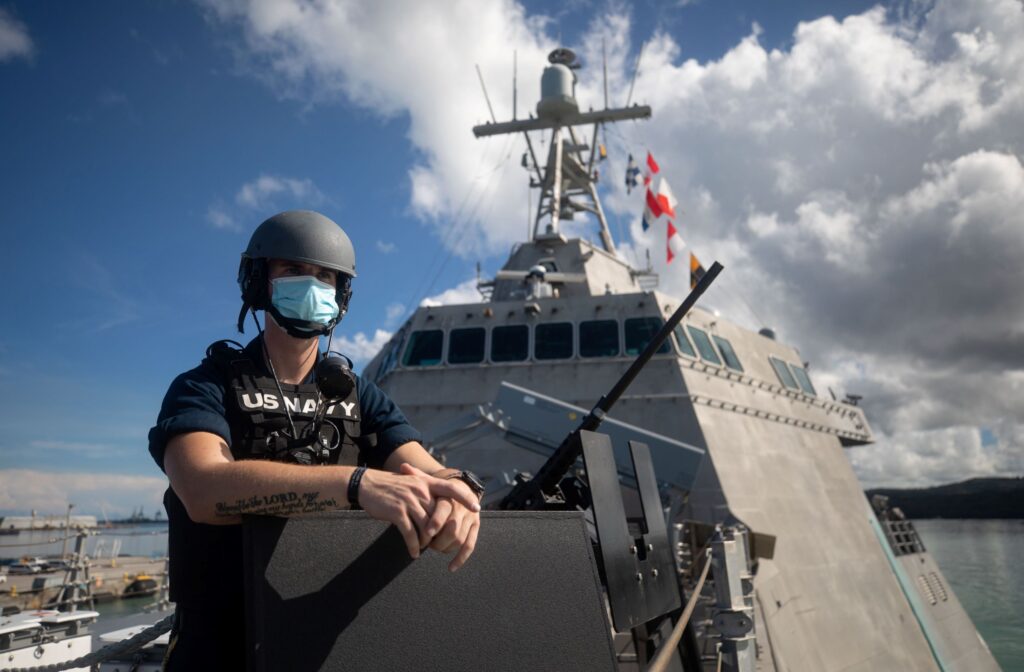
NATIONAL HARBOR — We have often seen the rise and fall of new terminology to express renewed, or sometimes diminished, value placed upon different regions of the globe as the geography of national interests waxes and wanes. Until recently, the geographical expression that dominated foreign and national security policy documents of the United States in the Pacific region was “Asia-Pacific.” This term, however, is increasingly giving way to “Indo-Pacific” in national security policy documents and discourse, as can be seen in the Sea-Air-Space Show Guide and Directory.
What is prompting this evolution in geospatial conception? In large part, the shift to Indo-Pacific has been driven by two key factors: an observed increase in China’s interests in the Indian Ocean region and the increasing commercial, cultural, political, and security interconnections between the Indian and Pacific Ocean communities. The symbolic change to recognizing the Indo-Pacific as the now-dominant strategic region in the areas adjoining eastern Asia began with the Obama administration’s late 2011 “Pacific Pivot,” and continued with the Trump administration’s 2017 concept, the “Free and Open Indo-Pacific.” A year later, U.S. Pacific Command was renamed as the Indo-Pacific Command. Now, the Biden administration has published its own “Indo-Pacific Strategy of the United States,” with remarkable similarities to the strategies of the previous administrations.
It’s worth considering though, what does the “Indo-Pacific” entail? Geographical concepts are inevitably contestable, as their construction is tailored to suit the purposes of the name-giver. In its most expansive interpretation, the Indo-Pacific can be thought of as the world’s largest region, spanning the distance from Russia’s Siberian coastal frontier and the beaches of California to the shores of South Africa and Oman. The broadly defined Indo-Pacific covers roughly half of the Earth’s surface and more than half its population. It is home to the world’s largest economies — the United States, China, Japan — and its smallest – Palau, Nauru, Tuvalu. The world’s two largest countries by population, India and China, and some of the smallest also reside within the scope of the Indo-Pacific.
What this vast expanse of sea and land holds for the United States is the largest and perhaps most dynamic international environment where American companies and military units operate. While the United States is undoubtedly a Pacific power, its ability to access the epicenter of Pacific activity in East and Southeast Asia is severely constrained by the nature of the same expansive geography. The continental United States is some 6,600 miles removed from Taiwan, 6,200 miles from Okinawa, 6,000 miles from Guam, 5,800 miles from South Korea and 5,300 miles from the main islands of Japan. The realities of these distances between the United States and its major Pacific allies, outposts, and partners are seldom considered, let alone understood. That a voyage by ship from San Francisco to the American military base at Okinawa may take anywhere from six to more than 14 days is a major complicating factor in the ability of the United States to fulfill its commitments to Pacific allies and partners.
The physical separation of the United States from its many allies and partners in the Western Pacific serves as the foundation for the forward positioning of major military assets. Indeed, the military, joint INDOPACOM command oversees roughly 375,000 military and civilian personnel across its area of responsibility. The primary naval means of maneuvering personnel and material as well as projecting power across the vast seascape of the region, the U.S. 7th Fleet, must operate with between just 50 and 70 vessels to manage almost 50 million square miles of sea, the largest area of responsibility of any forward-stationed American fleet. The strain on the fleet is compounded when one considers the need to counter the rapid and continuing expansion of the People’s Liberation Army Navy, coast guard and maritime militia.
The result has been a continuing fixation of American regional assets on the Western Pacific despite Washington’s ostensible recognition of the Indo-Pacific as a region of much greater scope in its official policy documents. Perhaps the most promising solution is the revival of the 1st Fleet, a concept most recently suggested by former Navy Secretary Ken Braithwaite to be based in both Singapore and Darwin, Australia. This new formation would take over the area of responsibility in the Indian Ocean and Southeast Asia from the 7th Fleet, thereby alleviating its divided attention between China and the Indian Ocean region — a region of growing interest but where little force structure or action has thus far been applied. Even if the 1st Fleet is returned to service, the massive mandate of American forces in the Indo-Pacific necessitates greater presence and mobility that can only be provided by more naval platforms. If the “Indo” of Indo-Pacific is to be anything more than a genuflection towards the Indian Ocean’s existence, the Navy needs to be empowered to maintain a credible presence in the West Pacific as well as the Indian Ocean.
The Center for Maritime Strategy, housed inside the Navy League of the United States, conducts and supports policy research and advocacy efforts across a broad spectrum of issues that impact the United States’ position as a maritime nation. CMS is hosting a ticketed breakfast at Sea-Air-Space 2022 on Tuesday, April 5.




